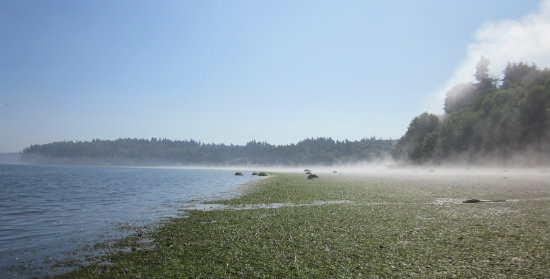You’ve come to the right place! It’s still DNR’s website, just more mobile-friendly and accessible.
Nearshore Habitat Program
The nearshore environment is a rich, complex, and important part of the greater Puget Sound ecosystem. Nearshore habitats are critical to populations of biologic and economic value, including shellfish, salmon, groundfish, seabirds, and marine mammals. They are also popular places for people to work and play. The purpose of DNR's Nearshore Habitat Program is to inform management decisions by providing information on status and trends in these important areas. Major projects include:
- Eelgrass monitoring
- Eelgrass stressor-response research
- Seagrass restoration
- Kelp monitoring
- Biotic community monitoring
- Washington Marine Vegetation Atlas
- Inventory Projects
|
Download data, interactive maps, Storymaps, web services |
Monitoring
This work constitutes one of DNR's stewardship activities. Monitoring results provide feedback on DNR's mandate to ensure environmental protection on aquatic lands. Results are also used for statewide initiatives and assessments, such as Results WA and the Puget Sound Partnership's Puget Sound Vital Signs.
The Nearshore Habitat Program is one component of a collaborative research effort called the Puget Sound Ecosystem Monitoring Program, formed by the Puget Sound Partnership. It completes long-term monitoring and investigates environmental patterns and trends. Under the authority of the Puget Sound Partnership, a series of government agencies monitor portions of the Puget Sound ecosystem as part of the Puget Sound Ecosystem Monitoring Program.
Reports are available at Nearshore Habitat Program Publications. Geographical data are available on our GIS Data Download site (data sets are listed in the Aquatics Table.
SeagrassNet Monitoring
The Washington State Department of Natural Resources has monitored a seagrass population at Dumas Bay since 2008. This research uses an ecological monitoring protocol, designed by SeagrassNet, to detect fine scale changes in local seagrass resources.
SeagrassNet is a global seagrass monitoring network that investigates the status of seagrass populations and the threats that affect these critical resources. The SeagrassNet program began in 2001 in the Western Pacific and now includes 126 sites in 33 countries with a global monitoring protocol and web-based data reporting system.
Please click this link to view our Esri Story Map on our SeagrassNet research.



